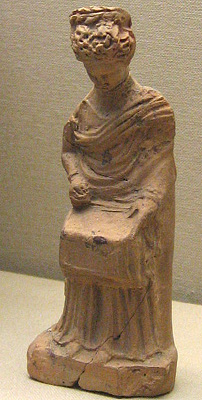 Woman writing on a folding tablet Cyprus, 4th century BCE |
In a letter written to his friend Erucius (circa 100 CE), Pliny the Younger praises their talented mutual friend, Pompeius Saturninus, for his rhetorical skills, his historical writing, and his poetry, which Pliny considers rivals the verses of Catullus. Since in their conversations together Saturninus proudly showed Pliny letters that he claimed were written by his wife, Pliny commends them to Erucius as highly accomplished, although he is cautious of accepting their origin. Typically Saturninus' wife is not named, but Pliny applauds Saturninus for her compositional talents. As Roman brides were usually considerably younger than their husbands, it is not surprising that some older husbands interested themselves in furthering the education of their wives, as did Pliny himself with his third wife, the child-bride Calpurnia (see Epistulae 4.19). |
| Legit mihi nuper epistulas; uxoris esse dicebat. |
| Plautum vel Terentium, metro solutum, legi credidi. |
| Quae sive uxoris sunt, ut affirmat, sive ipsius, ut negat, |
| pari gloria dignus qui aut illa componat aut uxorem, |
| quam virginem accepit, tam doctam politamque reddiderit. |
Click on the underlined words for translation aids and commentary, which will appear in a small window. Close this small window after each use.